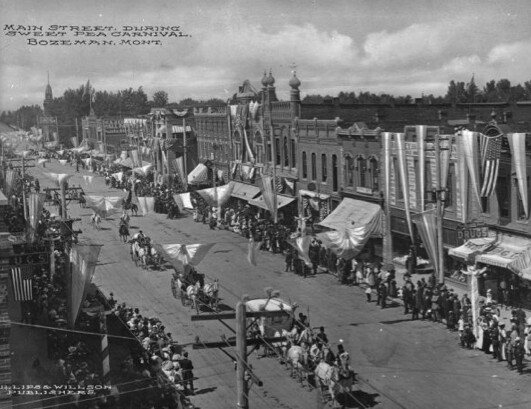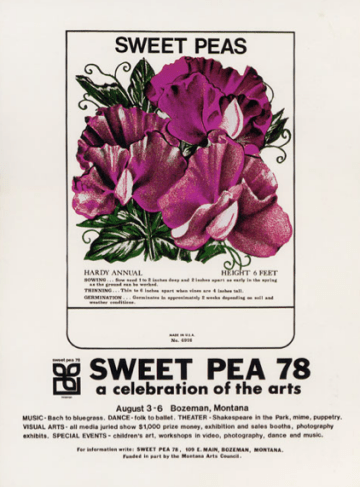Bozeman, Montana The Sweet Pea City
Sweet Pea From Carnival to Festival
Angie Ripple | Saturday Aug. 2nd, 2014
Bozeman and the Gallatin Valley have been known as the valley of the flowers since only native Americans roamed the area. In the early 1900’s over 17,000 acres of the valley were planted in edible peas harvested both for canning and seed. In 1906, Bozeman competed with Billings to gain the location for a lucrative sugar beet factory from Utah that was looking to place a new processing plant in Montana. In efforts to gain their business, a Mr. Buchanan, the new secretary of the Bozeman Commercial Club, now the Chamber of Commerce, in an endeavour to make Bozeman a commercial center, suggested a “Sweet Pea Carnival” after seeing Dr. and Mrs. JM Waters beautiful sweet peas at the corner of South Olive and 4th Street. The Waters’ made a living selling sweet peas by the car load to Butte and Helena.
Mr. Buchanan dubbed Bozeman the “Sweet Pea City” and the first Sweet Pea Carnival was held in August 1906 seeing a surprisingly large turnout. Bozeman quickly became known as the Sweet Pea Capital of the nation, and was second only to Portland’s Rose Carnival in the idea of presenting a floral carnival. Visitors riding trains to Bozeman for the carnival were greeted with fragrant bouquets of Sweet Peas. The first events featured a parade down Bozeman’s dusty and unpaved Main Street, an especially grand king and queen coronation, and a baseball game. The edible and fragrant sweet pea flower was the Carnival’s emblem and was used to promote the festivities.
WF Brewer a daily reporter for many Montana newspaper including the Anaconda paper, Butte Miner, Montana Standard, Helena Record, Independent Record and Billings Gazette had much to do with the publicity of the original Sweet Pea Carnivals. Headlines in all the daily and weekly papers throughout the state read: One More Week, Reduced Rates on all Railroads, Prizes for Best Floats, and All People Having Sweet Peas are Asked to Turn Them In. In 1909 Brewer wrote “Bozeman’s 1909 Sweet Pea Carnival exceeds all previous efforts.”
The Sweet Pea Carnival parade’s were an event that T. Bryan Story spent weeks preparing his horse tack for, according to his daughter Winifred Lovelace as quoted in an undated article from the Bozeman Daily Chronicle. Story also wrote the words to the song “The Sweet-Pea Carnival” in 1909 and participated in many Carnival parades and events. Impressive floats for the Carnival parade were designed and created using Sweet Peas and other flowers, and Main Street business were decorated with elaborate bunting and ribbons.
In Frances Teslow’s Winter Quarter Term Paper (donated to the Renne Library by Dr MG Burlingame in 1978) she writes “The Carnivals were the first attempt of the little city, Bozeman, to assist in inspiring in the hearts of the people of Montana the love of the beautiful and the joy and dignity of living.” Her accounts of the original Carnivals are priceless, noting that “the same people were doing all of the work year after year with no real commercial benefit other that to restaurants and hotels”, commercial benefit and the attraction of the sugar beet factory were the initial stimulus for the carnival, so to see no real reward made it difficult to want to continue. She notes the benefits of the carnivals were the beautification of homes and lawns, kept well trimmed and flower beds beautiful, making Bozeman the prettiest city in Montana.
Although Bozeman did not receive the sugar beet processing plant the Carnival continued to run from 1906 to 1914 as a day long celebration, it took a break in 1915, and the final Sweet Pea Carnival was held in 1916 before the first World War brought it, and the prolific pea harvesting to a halt. Teslow writes,“the fact that the war was getting under way in Europe and thepeople were all upset led to the discontinuation of the carnival.”
In 1977 eight young creatives, Eileen Tenney, Nancy House, Bev and George Mattson, Kathy and Rich Helzer, John Sincell (deceased) and Marietta Sincell Johnstone, had the vim and whimsy to pull together a festival of the arts that they chose to call the Sweet Pea Festival. The name Sweet Pea was chosen for the festival because it brought back the memory of the Sweet Pea Carnival of yesteryear, yet having nothing to do with the agricultural competition that brought together the original Carnival. The idea was not to bring back the old Sweet Pea, but to create a festival of the arts with the flavor and memory of the original.
In August 1978, with help from a grant from the Montana Arts Council, and donations from First Security Bank and Owenhouse Ace Hardware; two still very vibrant businesses on Bozeman’s Main Street, the Sweet Pea Festival was born. The concept was intended to bring regional artists to Bozeman to display and sell their artwork, bring musicians and dancers, as well as performing artists and theatre; to include Montana Shakespeare in the Parks, a long lasting Sweet Pea tradition. The first Sweet Pea Festival sprawled from one end of town to the other; from Willson school, to Cooper Park, the campus of Montana Sate University, to Main Street and to the now home of the festival, Lindley Park. The format for the first festival included a parade, arts and crafts, music, children’s activities, food concessions, flower show and Sweet Pea Ball, run, poster contest and t shirt sales. Remarkably most of the original format is still being used today.
The purchase of a $2 dollar button was your ticket into all festival events, thousands of buttons were hand pressed by the founders the first year, each taking their turn at pressing 300-500 each. The first year they sold 4,000 buttons, today the Festival’s attendance averages 15,000 people. Sweet Pea buttons were a mainstay for festival admission through 2007, and they are now sold for $1 a piece each year as a commemorative token.
Never believing they could possibly fail the eight founders had to learn how to ask for monetary help, orchestrate volunteers and market the event. “We worked long and hard, but still managed to have a good time. We couldn’t have succeeded without the help of many volunteers. We are especially proud to see families enjoying the activities, lining main street for the parade after watching children of all ages finish the run, children being creative with wood, nails, a hammer and paint, people of all ages having a tator pig and listening to music or dancing their troubles away in the bowl, artists selling their art, plus school and family reunions choosing the first weekend in August to come together to visit, while enjoying the
wonders of the Sweet Pea Festival of the Arts.” reflects Eileen Tenney.
For over 35 years now the Sweet Pea Festival has continued with the mission of “promoting and cultivating the arts.” Current Executive Director Andria Huntsinger, along with a board of directors, and hundreds of volunteers strive to create a memorable event for the Bozeman community each year. The Sweet Pea Festival is now a registered 501(c)(3) non-profit organization. All money raised in excess of what is needed to operate the Festival is given back to the community in the form of grants for the arts, art education, and special projects in the Bozeman area.
The magic and whimsy of the original Sweet Pea Carnival can still be seen in the eyes and expressions of both young and old along Bozeman’s Main Street during the Sweet Pea Parade, while dancing in Lindley’s grassy bowl, as Chalk on the Walk masterpieces are made, or the Sweet Pea Run is completed. Bozeman holds and welcomes a great many people that can come together to celebrate our “little city” each August.
| Tweet |
